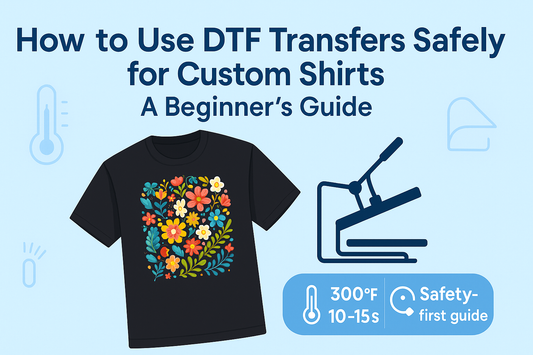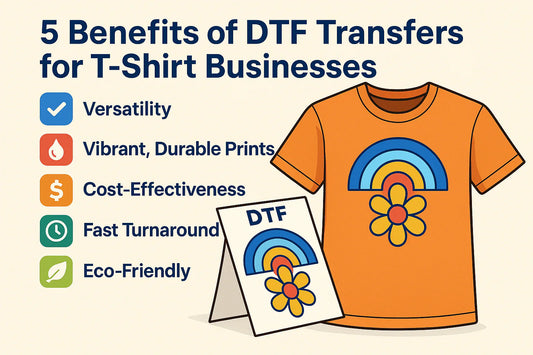Direct-to-Film (DTF) transfer printing is a modern technique that allows vibrant designs to be printed on various materials. This method is gaining popularity because it can be used on a wide range of fabrics and even non-fabric surfaces, making it a versatile option for custom apparel and unique items. In this article, we will explore the types of apparel and materials suitable for DTF transfers, along with tips for successful application and creative uses.
Key Takeaways
- DTF transfers can be applied to diverse fabrics like cotton, polyester, and blends, ensuring vibrant prints.
- This method is not limited to textiles; it works on materials such as wood, metal, plastic, and ceramics.
- Custom apparel like t-shirts and hoodies can be easily personalized with DTF transfers.
- Choosing the right transfer paper and preparing the fabric properly are essential for successful applications.
- DTF printing allows for intricate designs and a wide color range, making it ideal for creative projects.
Understanding DTF Transfers and Their Versatility
What is DTF Transfer Printing?
DTF, or Direct-to-Film, is a modern printing method that allows you to create custom designs on various materials. This technique involves printing your design onto a special film, which is then transferred onto the desired surface using heat. DTF printing is known for its vibrant colors and durability, making it a popular choice for custom apparel and other items.
How Does DTF Transfer Work?
The DTF transfer process is straightforward:
-
Design Creation: Start by creating your design on a computer.
-
Printing: Print the design onto a special film using a DTF printer.
-
Transfer: Use a heat press to apply the design onto the fabric or material.
This method allows for full-color designs without limitations, making it suitable for a wide range of applications.
Benefits of Using DTF Transfers
Using DTF transfers comes with several advantages:
-
Versatility: DTF can be used on various fabrics, including cotton, polyester, and blends, as well as non-fabric materials like wood and metal.
-
Durability: DTF prints are resistant to fading, ensuring that your designs remain vibrant over time.
-
Cost-Effective: Compared to traditional methods like screen printing, DTF is often more affordable, especially for small batches.
DTF printing is a game-changer in the world of custom designs, offering flexibility and high-quality results that can elevate any project.
Popular Fabrics for DTF Transfers
Printing on Cotton
Cotton is a popular choice for DTF transfers due to its softness and breathability. It absorbs ink well, allowing for vibrant prints. Here are some key points:
Printing on Polyester
Polyester is another great fabric for DTF transfers. It offers a smooth surface that enhances print quality. Key benefits include:
- High durability
- Vibrant colors
- Less prone to fading
Printing on Blended Fabrics
Blended fabrics, like cotton-polyester mixes, combine the best of both worlds. They provide:
- Good breathability
- Enhanced durability
- Versatile for various apparel types
Printing on Specialty Fabrics
Specialty fabrics, such as nylon and treated leather, can also be used for DTF transfers. However, they require careful handling:
- Ensure proper heat settings
- Test on a small area first
- Ideal for unique custom designs
Choosing the right fabric is crucial for achieving high-quality DTF transfers. Understanding the fabric's properties can help you create stunning custom apparel.
Applying DTF Transfers to Different Apparel Types

Custom T-Shirts and Hoodies
DTF transfers are perfect for custom apparel printing like t-shirts and hoodies. They allow for vibrant designs that stand out. Here are some key points:
-
Comfortable Fit: DTF transfers work well on cotton and polyester blends, ensuring a soft feel.
-
Durability: The prints are long-lasting and can withstand multiple washes without fading.
-
Design Flexibility: You can create unique designs for any occasion, from casual wear to special events.
Sportswear and Jerseys
When it comes to sportswear, DTF transfers shine. They are ideal for jerseys and athletic gear. Here’s why:
-
Breathable Fabrics: DTF works well on moisture-wicking materials, keeping athletes comfortable.
-
Team Spirit: Easily customize jerseys with team logos and player names.
-
Durable Prints: The transfers are designed to last, even with heavy use.
Accessories like Hats and Bags
DTF transfers can also be applied to various accessories, making them versatile for custom designs:
-
Hats: Perfect for adding logos or fun designs.
-
Bags: Great for personalizing tote bags or backpacks.
-
Unique Touch: DTF allows for intricate designs that can make any accessory stand out.
DTF transfers provide a fantastic way to personalize your apparel and accessories, making them unique and special. Whether for personal use or business, the possibilities are endless!
Using DTF Transfers on Non-Fabric Materials

Printing on Wood
DTF Transfer printing can be used on wood surfaces, allowing for creative designs on items like plaques and coasters. Here are some tips for successful application:
-
Choose smooth wood: A polished surface helps the transfer adhere better.
-
Pre-treat the wood: Ensure the surface is clean and free of dust.
-
Use a heat press: This ensures even heat distribution for a strong bond.
Printing on Metal
Metal surfaces can also be enhanced with DTF transfers. This method is great for creating custom signs or decorative items. Consider the following:
-
Select the right metal: Aluminum and stainless steel work best.
-
Clean the surface: Remove any grease or dirt before applying.
-
Adjust heat settings: Different metals may require different temperatures.
Printing on Plastic
Plastic items, such as phone cases or containers, can be personalized using DTF transfers. Here’s how:
-
Pick the right plastic: Not all plastics are suitable; choose those that can withstand heat.
-
Prepare the surface: Clean thoroughly to ensure adhesion.
-
Test a small area: Before applying the full design, test on a small section to check compatibility.
Printing on Ceramics
Ceramics can be beautifully decorated with DTF transfers, making them perfect for custom mugs or tiles. Follow these steps:
-
Use glazed ceramics: The smooth surface helps with adhesion.
-
Heat press application: Ensure even pressure and heat for the best results.
-
Allow to cure: Let the transfer set for a few hours before use.
DTF Transfer printing is a versatile method that allows you to personalize a wide range of materials beyond fabric. With the right preparation and techniques, you can create stunning designs on wood, metal, plastic, and ceramics, making your projects truly unique!
Tips for Successful DTF Transfer Applications
Choosing the Right Transfer Paper
When it comes to DTF transfers, selecting the right transfer paper is crucial. Here are some tips:
-
Light Fabrics: Use transfer paper designed for light fabrics to ensure vibrant colors.
-
Dark Fabrics: For dark materials, opt for transfer paper that provides better opacity.
-
Test First: Always test a small piece before applying to the entire fabric.
Preparing Your Fabric
Proper preparation of your fabric is key to a successful transfer. Follow these steps:
-
Wash the Fabric: Remove any dirt or chemicals that might prevent adhesion.
-
Iron the Fabric: Ensure it’s smooth and free of wrinkles.
-
Positioning: Place the transfer paper on the fabric where you want the design to appear.
Heat Press vs. Iron-On Methods
Using a heat press is generally more effective than an iron. Here’s why:
-
Even Heat: A heat press provides consistent heat across the design.
-
Pressure Control: It allows for better pressure application, ensuring the transfer adheres well.
-
Time Efficiency: Heat presses often require less time than ironing.
Troubleshooting Common Issues
If you encounter problems, here are some common issues and solutions:
-
Peeling: Ensure you’re peeling at the right temperature—some transfers need to be peeled hot, while others should be cold.
-
Fading: To avoid fading, wash the fabric inside out and use cold water.
-
Misalignment: Use a ruler or alignment tool to ensure your design is centered before applying.
Remember, the success of your DTF transfer depends on careful preparation and following the right steps. By taking the time to choose the right materials and methods, you can achieve stunning results that last!
Creative Uses for DTF Transfers
Custom Home Decor
Custom DTF transfers can transform your living space. You can use them to create unique items like:
-
Pillowcases with your favorite quotes or designs.
-
Curtains that match your room's theme.
-
Tablecloths for special occasions.
Customizing your home decor has never been easier or more fun. With DTF transfers, you can make every piece truly your own.
Personalized Gifts
Creating personalized gifts is a breeze with DTF transfers. Here are some ideas:
-
T-Shirts with custom messages for birthdays or anniversaries.
-
Tote bags featuring fun designs or inspirational quotes.
-
Hoodies that showcase your loved ones' favorite things.
Business Merchandise
DTF transfers are great for small businesses. You can:
- Design logos and slogans that stand out.
- Apply transfers to various merchandise like tote bags and aprons.
- Create promotional items that leave a lasting impression.
Custom accessories make great gifts and promotional items. They are not only unique but also show that you put thought into your gift.
Conclusion
In summary, DTF transfers are a great way to add your personal touch to various items. Whether you're making custom t-shirts, bags, or other fabric products, the process is simple and the results are impressive. By following the guidelines in this article, you can create professional-looking designs right at home. Remember to pick the right materials, stick to the instructions, and take your time for the best outcome. Enjoy your crafting journey!
Frequently Asked Questions
What is DTF transfer printing?
DTF transfer printing, or Direct-to-Film printing, is a modern method where designs are printed on a special film and then transferred onto fabrics using heat.
What types of fabrics can I use with DTF transfers?
You can use DTF transfers on various fabrics like cotton, polyester, blends, and even specialty fabrics like leather and denim.
How long do DTF transfers last?
DTF transfers are designed to be durable and can last through many washes without fading or peeling.
Can I use DTF transfers on non-fabric items?
Yes! DTF transfers can also be applied to materials like wood, metal, plastic, and ceramics.
What are the benefits of using DTF transfers?
DTF transfers offer vibrant colors, easy application, and the ability to create detailed designs without extra costs for color.
How do I apply DTF transfers?
You can apply DTF transfers using a heat press or an iron. Just ensure you follow the temperature and pressure guidelines for the best results.











0 comments